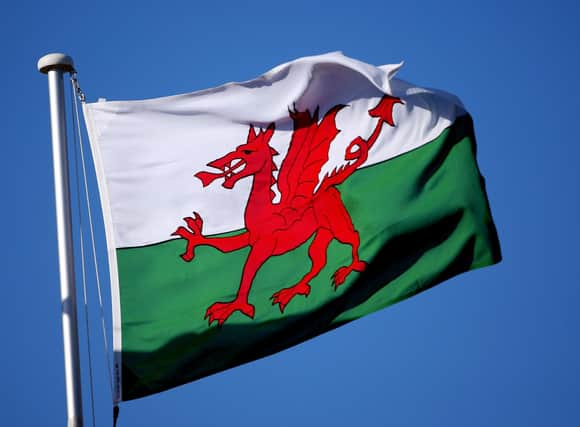St David’s Day 2021: how to say 'Happy St David’s Day' in Welsh, why people wear daffodils – and what is the flag?


Millions of people in Wales are celebrating St David’s Day today (1 March).
Although the country’s national day is not an official public holiday, the Welsh usually go all out to commemorate it.
Advertisement
Hide AdAdvertisement
Hide AdYet celebrations will be quite different this year due to the pandemic, with many of the traditional parades and parties cancelled.
So, how do you say “Happy St David’s Day” in Welsh, what is the celebration all about - and what is the patron saint’s flag?
Here is everything you need to know.
How do you say ‘Happy St David’s Day’ in Welsh?
Many people are wondering how to say "Happy St David’s Day" in the Welsh language.
It is: “Dydd Gŵyl Dewi Hapus”.
Those who aren’t well-versed in the language will be wondering how that is pronounced, which is: “Deethe goo-eel Dew-ee happ-iss".
In “dydd”, the “th” sound is soft, like “the”.
Why is St David’s Day celebrated?
Advertisement
Hide AdAdvertisement
Hide AdSt David’s Day is an annual celebration, falling on 1 March each year, which commemorates the patron saint of Wales, Saint David.
The national day is similar to St Andrew’s Day in Scotland, or St Patrick’s Day in Ireland.
Many people wear a leek or daffodil on the day - the national emblems of the country.
In normal times, the Welsh would host parties involving traditional dances and songs, including the national anthem, Hen Wlad Fy Nhadau (Land Of My Fathers).
Advertisement
Hide AdAdvertisement
Hide AdChildren would also join in with the celebrations, wearing traditional costumes.
Boys wear a white shirt, waistcoat and black trousers, and girls dress up in petticoats, overcoats, bonnets and a tall hat.
On the day, a Te Bach is enjoyed - a tea with bara brith, which is famous Welsh fruited bread, and teisen bach, a Welsh cake.
Unfortunately, the usual parades will not be permitted to go ahead in 2021 due to the national coronavirus lockdown in Wales.
Advertisement
Hide AdAdvertisement
Hide AdHowever, St David’s Day celebrations will still be going ahead virtually, with plenty of online events, concerts and festivities taking place.
Who was the patron saint of Wales?
Saint David is thought to have been born between 462 and 515 AD.
Legend has it that his mother gave birth to him on a Pembrokeshire cliff top in the midst of a wild storm.
The saint was educated in Cardiganshire, before going on a pilgrimage through south Wales and the west of England.
Advertisement
Hide AdAdvertisement
Hide AdDuring his journey, he is believed to have founded religious centres such as Glastonbury and Croyland.
He also embarked on a pilgrimage to Jerusalem, it is thought, where he was made an archbishop.
According to the National Museum, St David settled at Glyn Rhosyn (St David's), in south-west Wales, where he established a strict, ascetic religious community.
Folklore says that Saint David performed miracles throughout the country during the sixth century.
Advertisement
Hide AdAdvertisement
Hide AdOne legend has it that he made the ground rise up under him so he was able to preach to a large crowd at the Synod of Llanddewibrefi.
A white dove was seen sitting on his shoulder, which is why it became his emblem.
He was buried at the site of St David's Cathedral, and his shrine became a popular place of pilgrimage throughout the Middle Ages.
Why do people wear leeks and daffodils on St David’s Day?
People have been wearing and eating leeks on St David’s Day at least since the sixth century.
Advertisement
Hide AdAdvertisement
Hide AdThe tradition is thought to have been established after soldiers of the king Cadwaladyr were encouraged to wear the vegetable in their helmets during a battle against the Saxons.
The idea was that the symbol would help the soldiers to recognise each other and protect them from friendly fire.
Yet experts think it is likely that the leek tradition predates Saint David by hundreds, and even thousands, of years, to a time when Druids lived on the Island of Anglesey.
At this point in history, leeks were thought to be a cure for the cold, able to protect soldiers against wounds in battle and they were even used for warding away evil spirits.
Welsh people also adorn daffodils on St David’s Day.
Advertisement
Hide AdAdvertisement
Hide AdThe Welsh for leek is “Cenhinen”, while the Welsh for daffodil is “Cenhinen Pedr”, meaning Peter’s Leek.
Due to the linguistic similarity, it is believed that the daffodil became a popular alternative to the leek after St David’s Day became a national festival during the 18th century.
The daffodil was soon established as a national symbol for Wales.
What is the flag of St David?
St David’s flag, representing the patron saint of Wales, features a yellow cross on a black background.
Advertisement
Hide AdAdvertisement
Hide AdIt has been used on occasion as an alternative to Wales’ official flag, but it is traditionally flown on St David’s Day.
The origins of the flag are uncertain, but it is thought to have gained prominence in the early 20th century.
Some claim it dates back to the seventh century.